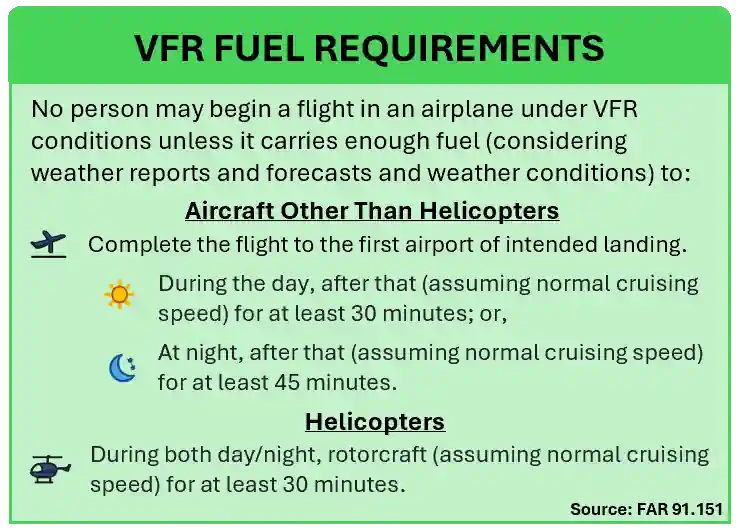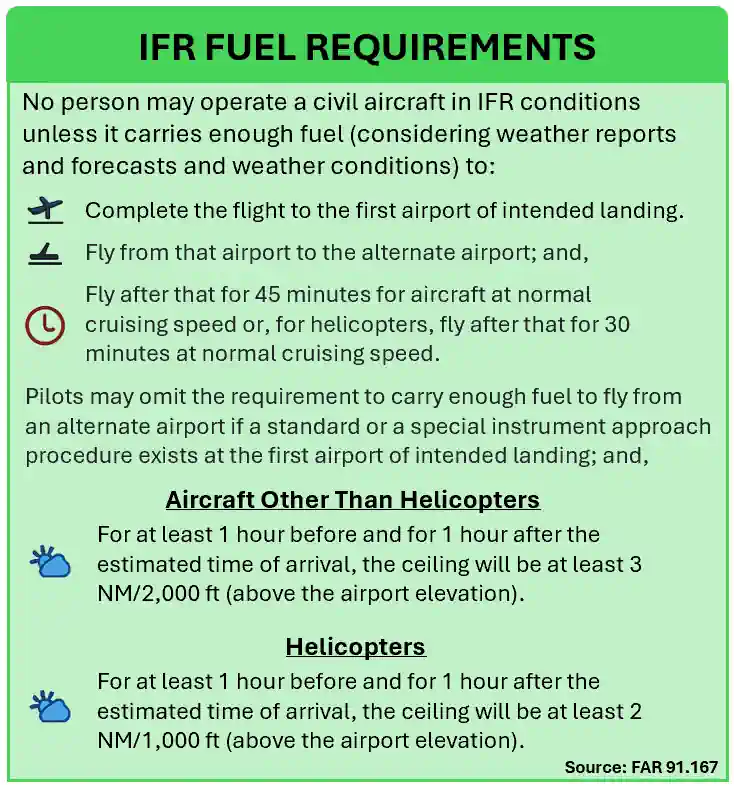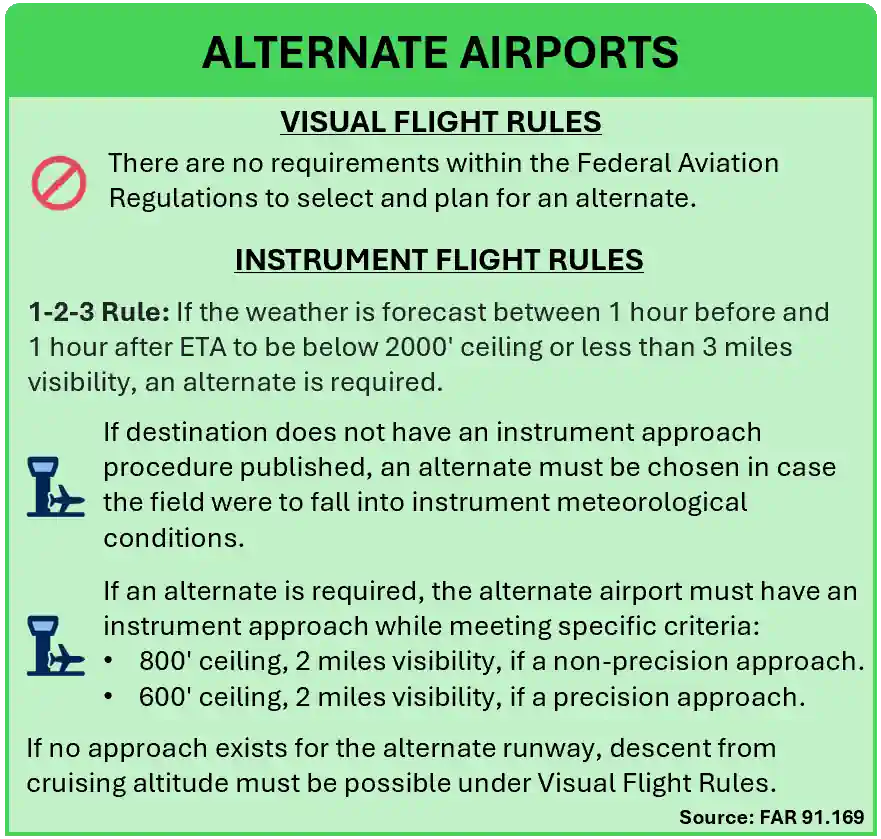Aviation Fuel Planning
Proper prior fuel planning ensures the appropriate amount of fuel for the flight, taking into account required or desired reserves.
Introduction to Aviation Fuel Planning
- Fuel to power an aircraft is of clear consequence to performance.
Fuel Planning Considerations
- Alternate requirements (is an alternate required, and if so, how much fuel is required?).
- Type of fuel at destination and alternate (what fuel is provided, and is it self-serve or full-serve?).
- Fuel availability (are the pumps working?).
- Aircraft weight limits relative to required performance (is a lighter weight required to takeoff?).
Aviation Fuel Reserve Requirements
-
VFR Fuel Requirements:
- VFR fuel requirements are governed by FAR 91.151. [Figure 1]
- No person may begin a flight in an airplane under VFR conditions unless it carries enough fuel (considering weather reports and forecasts and weather conditions) to:
- Complete the flight to the first airport of intended landing.
- During the day, after that (assuming normal cruising speed) for at least 30 minutes; or,
- At night, after that (assuming normal cruising speed) for at least 45 minutes.
- No person may begin a flight in a rotorcraft under VFR conditions unless there is enough fuel (considering weather reports and forecasts and weather conditions) to fly to the first point of intended landing and, assuming normal cruising speed, to fly after that for at least 20 minutes.
-
IFR Fuel Requirements:
- IFR fuel requirements are governed by FAR 91.167. [Figure 2]
- No person may operate a civil aircraft in IFR conditions unless it carries enough fuel (considering weather reports and forecasts and weather conditions) to:
- Complete the flight to the first airport of intended landing.
- Fly from that airport to the alternate airport; and,
- Fly after that for 45 minutes for aircraft at normal cruising speed or, for helicopters, fly after that for 30 minutes at normal cruising speed.
- Although the 45-minute rule above will never change, pilots may omit the requirement to carry enough fuel to fly from an alternate airport if:
- A standard instrument approach procedure to, or a special instrument approach procedure exists at the first airport of intended landing; and,
- Appropriate weather reports or weather forecasts, or a combination of them, indicate the following:
-
Aircraft Other Than Helicopters:
- For at least 1 hour before and for 1 hour after the estimated time of arrival, the ceiling will be at least 3 NM/2,000 ft (2,000 feet above the airport elevation, and the visibility will be at least three statute miles).
-
Helicopters:
- At the estimated time of arrival and for 1 hour after the estimated time of arrival, the ceiling will be at least 2 NM/1,000 ft above the airport elevation, or at least 400 feet above the lowest applicable approach minima, whichever is higher, and the visibility will be at least two statute miles.
-
- Pilots may omit fuel planning for an alternate when an alternate is not required.
-
Recalculating Fuel Reserves Inflight:
- When flights do not proceed as planned, fuel planning numbers calculated on the ground may become inaccurate.
- If changing course or destination in a way that is significantly different from the planned route, pilots must recalculate fuel reserves.
- With fuel burn at cruise already known, pilots must calculate the fuel burn for their new cruise distance/time, as well as add the appropriate reserve.
- Example:
- Assume there is a new destination with a straight line distance of 20 NM away from the airplane's current location.
- Fuel burn at cruise is known to be 7 GPH.
- Time to destination with current winds is 14 minutes.
- The fuel burn at cruise is therefore 1.63 total gallons.
- A 30-minute reserve requires 3.5 gallons, and a 45-minute reserve requires 5.25 gallons.
- Assuming the cruise burn at cruise and the reserves are available, it is a viable diversion (note that if diverting due to unplanned circumstances, the reserve fuel covers the diversion).
Fuel Planning for Alternate Airports
-
Visual Flight Rules:
- There are no requirements in the Federal Aviation Regulations for selecting and planning an alternate. [Figure 3]
- The lack of a requirement does not preclude pilots from being prepared.
-
Instrument Flight Rules:
- FAR 91.169 outlines a 1-2-3 rule: [Figure 3]
- If the weather is forecast between 1 hour before and 1 hour after ETA to be below 2000' ceiling or less than 3 miles visibility, an alternate is required.
- In addition to the 1-2-3 rule, if your destination does not have an instrument approach procedure published, an alternate must be chosen in case the field were to fall into instrument meteorological conditions.
- If an alternate is required, the alternate airport must have an instrument approach while meeting specific criteria:
- 800' ceiling, 2 miles visibility, if a non-precision approach.
- 600' ceiling, 2 miles visibility, if a precision approach.
- If no approach exists for the alternate runway, descent from cruising altitude must be possible under Visual Flight Rules.
- FAR 91.169 outlines a 1-2-3 rule: [Figure 3]
Fuel Planning Tips
- Be present during aircraft fueling. Verify fuel grade and quantity for the appropriate fuel tanks.
- Check for water or contaminants.
- Secure the fuel caps after checking the tank and double-check them before starting the engine.
- Determine available fuel in hours and minutes instead of gallons and pounds, and plan to land with at least an hour of usable fuel.
- Lean the mixture to achieve the best performance, range, and endurance.
- Recalculate range and endurance hourly to maintain adequate reserves.
- Understand how and when to use boost pumps, auxiliary tanks, fuel transfer pumps, and switch tanks before reaching pattern altitude.
- Use a timer to remind you to switch tanks during flight.
- Despite VFR pilots being exempt, plan for an alternate in case of unplanned weather, airport closure, or if fuel becomes unavailable.
Fuel Management
- The AOPA provides fuel management videos, quizzes, and publications for pilot reference.
Fuel Planning Case Studies
- National Transportation Safety Board (NTSB) Identification: NYC08FA020:
- A total loss of engine power due to fuel starvation as a result of the pilots' improper in-flight fuel management.
Aviation Fuel Planning Conclusion
- Fuel is all about time.
- More fuel means more options.
- Pilots should always carry enough fuel, plus a reserve for an approach and landing at the destination or alternate.
- The approach and landing are additions above those required by the operation (IFR or VFR).
- See Negron Legal Interpretation for more.
- Tools like engine monitors shed light on in-flight fuel burn performance.
- Other tools, like ASA's CX-3 Flight Computer [Amazon], are resources for pilots to utilize during fuel planning.
- Still looking for something? Continue searching:


